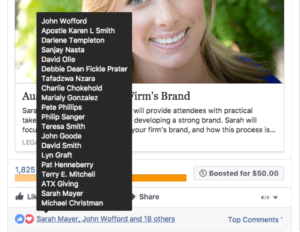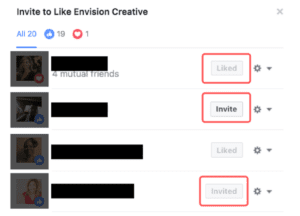Building a Facebook marketing strategy from scratch is a long, daunting task that sometimes leads to more problems than benefits—due to the sheer number of options at your disposal. If you google “Facebook marketing strategies,” it can get even more confusing. There’s just too much going on.
Developing a Facebook Marketing Strategy
I’ve seen many a fine strategy go down the drain because there were too many elements packed into one place. Simplicity is your best friend when it comes to implementing a Facebook strategy. I’m going to share the four basic tactics you need to succeed on the world’s biggest social network.
Keep in mind that this is a just a starting point. You’ll need to analyze your performance and decide what changes are needed as you continue to grow. But while you’re still building the foundation of your strategy, these are the four tactics you can’t ignore:
1. Invite the heck out of your engaged users.
There’s an oft-overlooked feature in Facebook that’s incredibly handy for building your audience WITHOUT having to pay a dime. What’s this magical feature, you ask? Inviting.
Let me explain through the lens of an example.
Log in to your Facebook account, go to your brand page and switch to “Business Manager” mode. Find a post with higher than average engagement and click on the reactions:

A window will open, showing all the reactions (engagements) your post has earned. To the right of each person’s name is a button that says one of the following three things:
- Invite
- Invited
- Liked

The “Invite” button is the one you want to use. Once you click, the user receives a notification telling them your brand has invited them to like your Facebook page.
After clicking, the button will gray-out and change to “Invited.”

If the user eventually accepts your invitation, the button will change to “Liked.”

The example I used was a boosted post, but it’s the same exact process with a regular post that hasn’t been boosted. If a post earns 20 reactions and 10 of them don’t follow your page, you have the opportunity to increase your audience substantially. Even if only 2 of the 10 decide to Like your page, that’s a 20% success rate. Imagine the possibilities when a post received hundreds (or even thousands) of engagements.
One word of caution: don’t invite more than 100 users in a single day or Facebook could flag your account for possible suspension.
Obviously, this technique works best when your content receives high engagement rates. The more people that react to your posts, the better chance you have to grow your followers through invitations.
2. Show some personality.
People love to follow brands on Facebook with unique personalities. Quirky, funny, personable, intriguing, and downright ridiculous posts often perform much better than dry, straight-laced content. Of course, if your business is a funeral home you’re not going to be focused on humor or quirk, but there’s always a way to showcase personality.
Here are some of my favorite ways to promote the personality of a brand’s Facebook page:
1. Go local and talk about the things that make your community unique.
Every year at Envision Creative we participate in Over the Edge, an event where sponsored individuals from hundreds of organizations rappel down the side of an Austin skyscraper. The event raises hundreds of thousands of dollars for the Make-A-Wish Foundation and it’s the perfect opportunity for us to give back while deepening our ties with the Austin community.
2. Show people the ins and outs of your company culture.
Does your organization do something special on employee birthdays or holidays? Talk about it on Facebook—or better yet, show it. Halloween is a big deal at Envision Creative—so big, in fact, that new hires usually learn on day one that costumes are a requirement (and a fun one!). We work half a day on Halloween, then black out the break room windows and watch a classic scary movie. Everyone gets photographed in the main lobby in their costumes and the photos are posted on Facebook.
3. Highlight your best clients.
Not many businesses do this, but it’s a fantastic way to show confidence in your work and business relationships. We love to give shout outs to our clients who exceed their goals, implement new products, services, or designs, have personal victories, and experience change.
3. Curate engaging content that mixes well with original content.
Unless you’re a massive organization (think Intel, Wendy’s, or Whole Foods) with a full content marketing team, you’ll need to curate third-party content.
Find content that matches the messaging and values of your own brand to strengthen your content mix. And, above all, the content needs to be interesting to your audience. The purpose of sharing content isn’t to create a constant stream of posts, it’s to build an engaged audience of brand advocates.
Pro tip: Use a social media content calendar to organize and schedule your content. This will save you a significant amount of time.
4. Get inspiration from your competitors.
Don’t reinvent the wheel. Are your competitors doing something cool, innovative, and unique that you’re not currently doing? Do you have the ability and capacity to execute those same ideas? Is their audience highly engaged?
Take notes of the most interesting competitor tactics you find and begin testing the ones that you feel would benefit your brand and audience. Don’t start from scratch when you can learn from the mistakes of others.
Together, these four tactics will give you a solid foundation from which you can begin to build your Facebook marketing strategy. It’s important to realize that you don’t have to do every single thing the “experts” tell you when you’re starting out.
Beginning simple and expanding your tactics once you’ve had a chance to produce positive results is the best way to create a successful strategy.
-FINAL(01-00)-White&Blue-01.svg)





